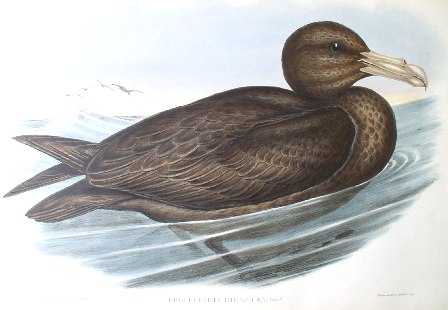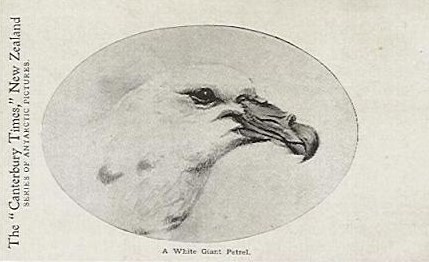
The habitat of the giant petrel is the cold water region of the southern hemisphere from the Antarctic continent northwards to about 30 degrees south. According to Oliver, the giant petrel may often be seen off shore sailing close to the water, every now and then flapping its wings several times in succession. Regularly it rises steeply in the air apparently to gain fresh impetus.
Known as the vultures of the Antarctic, it is its gross feeding habits which has earned it the approbrium. Oliver records observations of giant petrels on Campbell Island; “scavenging is the giant petrel’s real occupation and nothing washed ashore or floating dead on the sea is overlooked, be it the carcass of a huge whale or the body of a tiny penguin. They are continually on the cruise for food and the carcass of a seal washed ashore will bring several dozens around in a short time. Unless the remains are well decayed, there is not much chance of all the birds being able to feed at one time. One bossy bird will take up a position on the flank of the seal and make a small hole into the abdoninal cavity. The whole head and neck are thrust in, and the kind of mess made is best left to the imagination. As the seal decays more and more birds get their chance, gorging themselves on this carrion until often they are unable to take wing again. They then sit around on the ground for awhile or fruitlessly try to wash the oil and filth off their soiled plumage in the water. If disturbed while in this gorged state, they immediately vomit the stomach contents until they are light enough to take off.”
It is one of the earliest breeders on the Auckland and Campbell Islands, the single white egg being laid at the end of August. Although the giant petrels are timid and unfriendly, incubating birds will remain on the nest unless suddenly startled. At one’s approach, as recorded by Oliver, the sitting bird utters a rasping note which terminates in a coughing squawk. This is the warning to keep away. Should one persist, the bird will almost invariably eject a quantity of evil–smelling oil with skill and precision. The chicks do exactly the same. Hence the name stinker or stinkpot.
Maori made use of the bones of the giant petrel for the manufacture of needles and awls.

Other common names: —
Nelly, stinkpot, stinker, Antarctic giant petrel.
Description: —
Native bird
90 cm., 4.5 kg., variable plumage from white to grey brown; the Southern giant is separated from the Northern by having a green, not brownish tip to the bill.
Where to find: —
Although the Southern and Northern giant petrels are difficult to distinguish at sea, Southern giants are probably more common that Northern giants in New Zealand waters in winter and spring. The Northern breeds in the Chatham, Antipodes, Auckland and Campbell Islands. The closest breeding colony of Southern giants is the Australian Macquarie Island.
Youtube video —
Credit for the photograph: —
Canterbury Times Postcard, New Zealand Antarctic Series 1901-4.
Illustration description: —
Gould, John, Birds of Australia, 1840–48.
Reference(s): —
Heather, B., & Robertson, H., Field Guide to the Birds of New Zealand, 2000.
Oliver, W.R.B., New Zealand Birds, 1955.
Page date & version: —
Tuesday, 20 May 2014; ver2009v1

